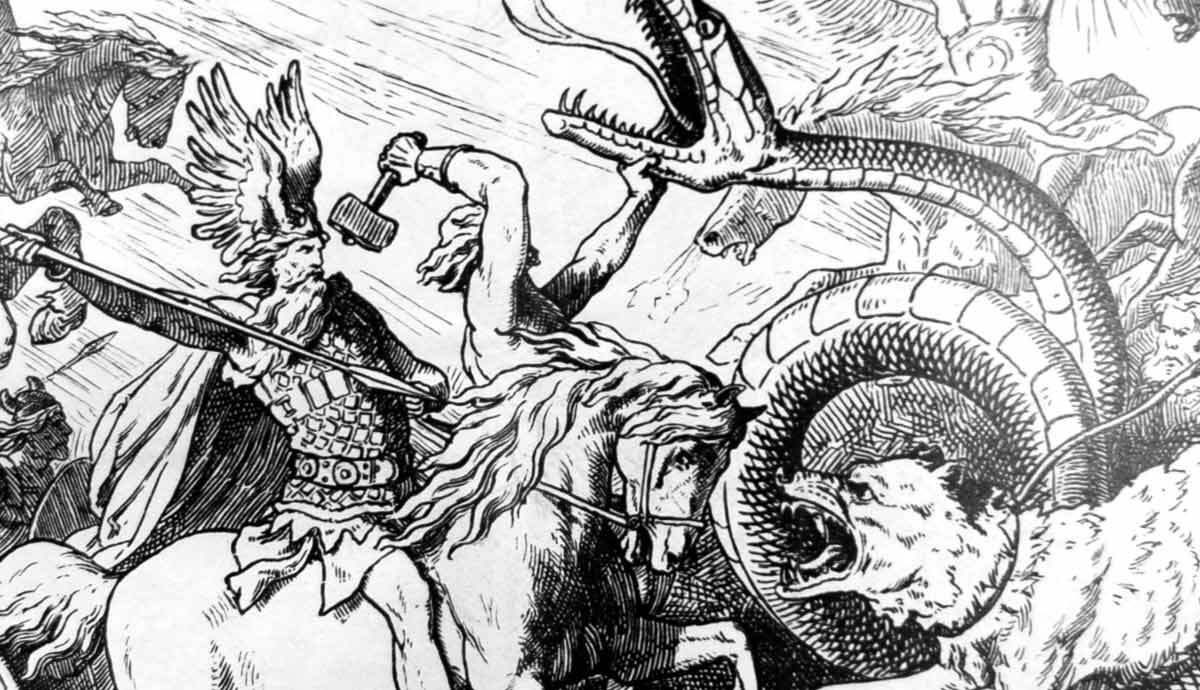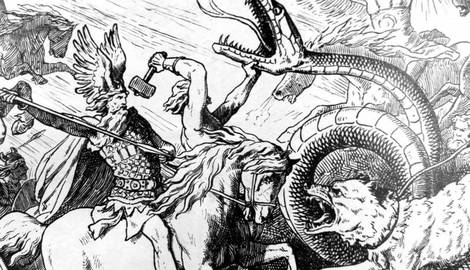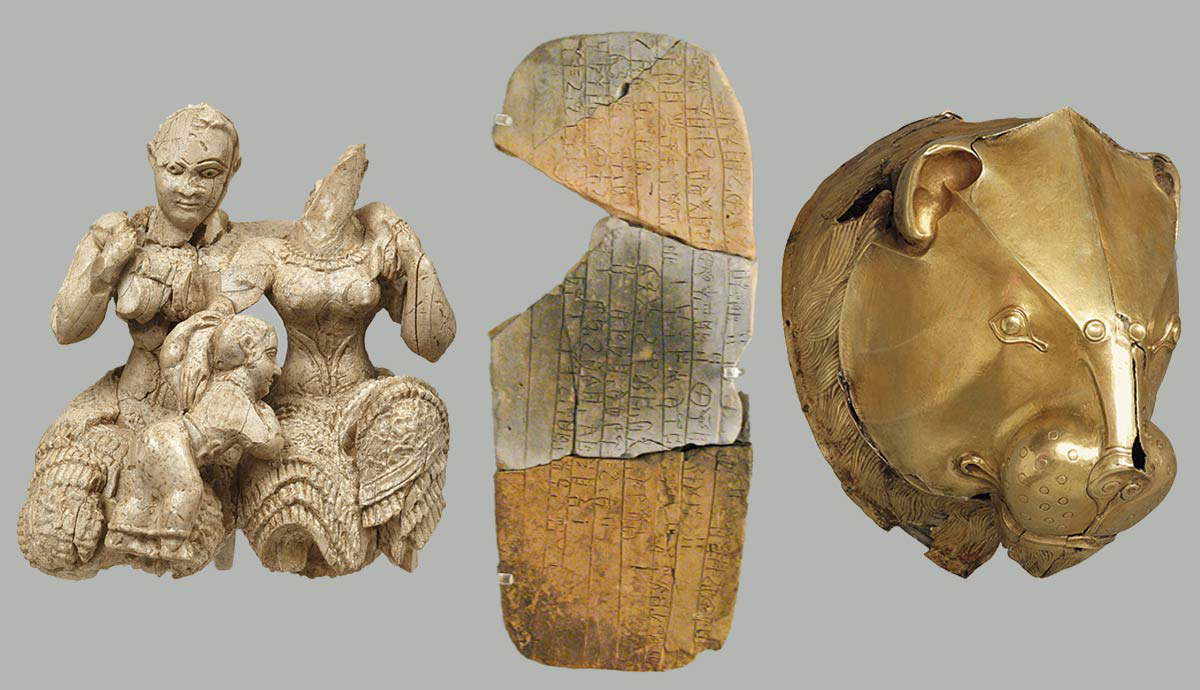
Ragnarök, the prophecy of the “Twilight of the Gods” in which most of the Norse gods are destined to die, has become a popular storytelling vehicle. It has been adapted so many times, from Marvel to Netflix, that few people could tell you the true details of the Norse apocalypse.
Read on to learn the secrets of Ragnarök. How was the prophecy revealed, what is the catalyst for the apocalypse, and what omens signal the coming of Ragnarök? What will happen in the great battle? Who is destined to live, who is destined to die, and what will happen afterward?
Ragnarök the Prophecy

The word Ragnarök means “twilight of the gods” in Old Norse. Unlike the other stories from Norse mythology, it does not recount the deeds, or misdeeds, of the gods. Instead, it is a prophecy about how the world will end. It was given to Odin, the leader of the Norse gods, by a Volva, a Viking seeress or witch.
The prophecy seems to be widely known. In one account, Odin questions a giant called Vafthrudnir about what will happen at the doom of men. The giant recounts details of the prophecy. In another story, Odin, disguised as a figure called High, tells a mortal king about the events at the end of days.
Ragnarök is an account of things yet to come, at least from Odin’s perspective. But there seems to be no question of Odin being able to change the course of destiny. In Norse mythology, destiny is written or weaved by the Norns, who are the Norse version of the fates.

While there seem to be many lesser Norns, the three principal fates are three sisters that live at the base of Yggdrasil, the world tree at the center of the Norse cosmos. The eldest is named Urd, which means “what once was.” The word was used to mean both fate and death. The middle sister is Verdandi, which means “coming into being”. The youngest is called Skuld, which means “what shall be”.
The Ragnarök prophecy as we know it today is recorded in three poems in the Poetic Edda, a 13th-century compilation of earlier stories, and in the Prose Edda, written by the Icelandic Christian author Snorri Sturluson in the 13th century. While the accounts agree on many particulars, there are also some key differences.
Causes of Ragnarök

Ragnarök does not just occur from nothing. A series of events create the prerequisite circumstances for Ragnarök to happen. Looking at these events, it is possible to say that the gods sowed their own fate.
It all begins with Loki, a giant who is allowed to live in Asgard among the gods due to a blood brotherhood pact that he made with Odin. But while Loki is often an ally of the gods, they still do not trust him. This is exemplified by the fact that when the gods discovered that Loki had three children with the giantess Angrboda, they decided that the offspring of such monstrous parentage could not be allowed to roam freely.
The gods placed each of the children of Loki and Angrboda where they thought they would do the least harm. The first, the great wolf Fenrir, was tricked and chained to a rock for eternity. The second, a serpent called Jormungandr, was thrown into the waters surrounding Midgard, the world of men. There he grew to such an enormous size that he could encircle the entire world. The third child, a half-living and half-dead giantess called Hel, was banished to be the ruler of the underworld in Niflheim, which became known as Helheim in her honor.
This treatment of his children may be why Loki decided to kill Balder, the son of Odin by his wife Frigg, and the most beautiful and beloved of the gods. Worrying about her son’s safety, Frigg secured promises from everything in existence that they would never hurt her son. This made him invincible, and the gods made a game of this, throwing weapons at him to watch them bounce off harmlessly.

Loki managed to learn that Frigg forgot to get a promise from the humble mistletoe plant. He made a dart from mistletoe and convinced Balder’s blind brother Hodr to throw the dart at him as part of the game. Balder died instantly and his soul went to Helheim. Despite the pleading of the gods, Hel would not release him.
The gods killed Hodr for his role in the death of Balder, and Hodr joined his brother in Helheim. The gods also broke their agreement with Loki and chained him to a rock for eternity. A poisonous snake was hung over his head to drip painful venom onto his body. His wife Sigyn tries to protect him from the worst of this by catching the poison in a bowl but every so often she must leave to empty the bowl. The pain that Loki feels causes earthquakes across the cosmos.
These are the preconditions for Ragnarök. The gods have imprisoned Loki and his dangerous offspring but they have also made enemies of these powerful beings.
Heralded by Omens

When it is time for Ragnarök to happen, it will be heralded by a series of omens and events. Three roosters will be the first to recognize these, and they will alert the gods, giants, and the dead.
A rooster called Fjalar will report to the giants in Jotunheim, their homeland. The rooster Gullinkambi will go to Asgard, the realm of the gods. Another red rooster will inform the dead in Helheim of the portents.
The portents that will be seen in the world of men start with a winter more bitter than any that has passed before that will last for three winters with no summers in between. The resulting hardship will rob mankind of its laws and morals. Humanity will descend into chaos and war, with brother slaying brother, father slaying son, and son slaying father.
The two great wolves, Skoll and Hati, who have been chasing the sun and the moon for an eternity will finally catch and devour their prey, plunging the world into darkness. The great tree Yggdrasil will also shudder with earthquakes, strong enough that mountains fall. They are also strong enough to break the prisons that hold Loki and his children.
Monsters Unleashed

A great force of giants and monsters will form an army to take on the gods. The dome of the earth will split open, creating a crack in the barrier that separates Muspelheim, the world of fire, from the rest of the cosmos. The great fire giant Surtr has been waiting for this moment and will lead the fire giants into the other world. He will set much of the world on fire with his flaming sword.
Loki will break his shackles and will descend to Helheim to meet up with his daughter. There the earthquakes will have shaken free a ship called Naglfar, which is made from the fingernails and the toenails of the dead. Loki, Hel, her guard dog Garm, and an army of the dead will sail this ship toward Asgard.
Jormungandr will emerge from the waters surrounding Midgard, causing tidal waves with the movement of his great body. He will also spew toxic venom onto the earth and into the air. Fenrir will break his shackles and begin to rampage through the world, devouring everything that lies before him.
These forces will converge on Asgard and meet the gods on a battlefield called Vigridr. Heimdall, the sentinel of Asgard, will signal the coming of the giant forces by blowing his horn. Odin will assemble his army of the brave and valiant dead who live in Valhalla. Balder and Hodr will be released from Helheim and join the army of the gods.
Divine Battle

The battle won’t go well for anyone, but Odin, leading the charge, will be among the first to die. He will be devoured by the great wolf Fenrir. But shortly after, Fenrir is killed by one of Odin’s sons, Vidarr. He has magical boots that allow him to stand in the wolf’s mouth without being devoured, so he will stab Fenrir in his brain.
Thor will fight with Jormungandr. While he will kill the serpent with his hammer, Jormungandr will spew so much poison onto Thor that he will also die within a few moments of his victory. The Vanir god Freyr and the fire giant Surtr will battle to their mutual destruction, as will Loki and Heimdall, and Hel’s dog Garm and the god Try.
We aren’t told the fates of all the gods but they probably all engaged in similar battles of mutual destruction. It is unclear what role the female goddesses may have played in the battle, as we aren’t told of them either taking arms or escaping.
One account says that Njord, one of the Vanir gods that lived among the Aesir, will return to his Vanir homeland at the doom of men. Whether this was to escape or to rally Vanir forces to join the gods in the fight is unclear. The latter seems possible since his son Freyr fights and dies.
In the end, the battle causes incredible destruction, with the world poisoned and set on fire. It can no longer sustain itself and sinks back into the waters of chaos.
Aftermath of the Battle

The older accounts of Ragnarök seem to end with the destruction of all things. But Snorri Sturluson suggests that a new world emerges from the ashes of the old.
He suggests that several gods survive, most of them from the younger generation. He lists Odin’s son Vidar and Thor’s two sons Modi and Magni surviving and inheriting their father’s hammer. Balder and Hodr, returned from the dead, also survive.

Mankind is also not entirely wiped out. A man and woman, called Lif and Lofthrasir, meaning “life” and “striving for life,” make it through by hiding in a wood called Hoddmimis Holt. Together they repopulate the world. A new sun, the daughter of the previous one, will rise into the sky.
Sturluson describes these gods as rebuilding a world that looks a lot like the old one. They create a new Asgard in a place called Idovall, which remained untouched by the war. The finest building was called Gimli and had a gold roof.
It seems very likely that this tale of renewal was created by Sturluson, who wanted to align the Norse myth with Christian ideas of salvation and the second coming. Earlier pagan Vikings, however, may have believed that Ragnarök was the end of all things.










